Iron isotope evidence of an impact origin for main-group pallasites
Affiliations | Corresponding Author | Cite as | Funding information- Share this article





-
Article views:305Cumulative count of HTML views and PDF downloads.
- Download Citation
- Rights & Permissions
top
Abstract
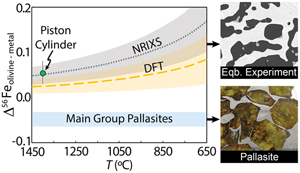
Figures
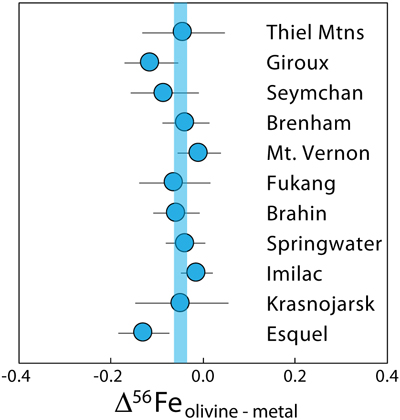 Figure 1 Measured Fe isotope fractionations between olivine and bulk metal in MGP. The blue band shows the weighted average for the 11 MGP measured in this study, plotted in order of cooling rate (Esquel slowest, Giroux fastest and Thiel Mtns. unknown; Yang et al., 2010). | 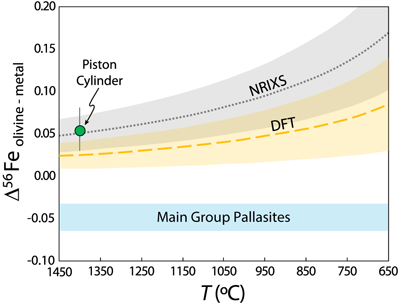 Figure 2 Grey and yellow bands show predicted olivine-metal Fe isotope fractionations at equilibrium, based on NRIXS and our DFT calculations, respectively. The piston cylinder datum is the weighted average of three isotopically equilibrated laboratory experiments. All methods show the same direction of equilibrium olivine-metal fractionation. MGP display the opposite sense of fractionation, suggesting that MGP olivine and metal are not in Fe isotopic equilibrium. | 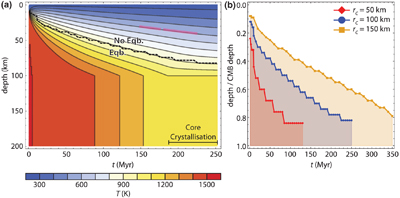 Figure 3 (a) Cooling and olivine-metal mass exchange model for a 200 km radius body with the core mantle boundary located at 100 km depth. The black dashed curve shows the time and depth of olivine-metal mixing above which Fe isotope equilibrium is inhibited. MGP formed above this curve. Also shown are the emplacement depths and periods of cloudy zone formation for the Imilac and Esquel meteorites, determined following Bryson et al. (2015). (b) Equilibrium curves for the same planetary radius but with different core radii (rC). The shaded regions indicate where olivine-metal equilibrium will occur for each model. Regardless of core size, olivine and metal always equilibrate when mixed near the core-mantle boundary. Note that in all cases models are terminated once the core is fully crystallised. | 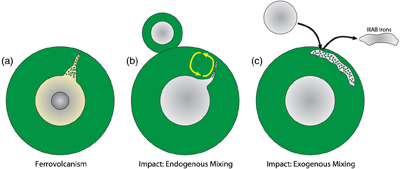 Figure 4 MGP formation models that account for shallow depths of olivine-metal mixing. Our Fe isotope data are most readily explained by model (c). |
| Figure 1 | Figure 2 | Figure 3 | Figure 4 |
top
Introduction
Pallasites are predominately composed of Fe-Ni metal and olivine. Traditionally, they are interpreted to be remnants of core-mantle boundary material from differentiated asteroids, an idea which continues to merit discussion (e.g., McKibbin et al., 2019
McKibbin, S.J., Pittarello, L., Makarona, C., Hamann, C., Hecht, L., Chernonozhkin, S.M., Goderis, S., Claeys, P. (2019) Petrogenesis of main group pallasite meteorites based on relationships among texture, mineralogy, and geochemistry. Meteoritics & Planetary Science 54, 2814–2844. https://doi.org/10.1111/maps.13392
). Alternatively, pallasites may form in the shallow mantle of an asteroid either by ferrovolcanism (Johnson et al., 2020Johnson, B.C., Sori, M.M., Evans, A.J. (2020) Ferrovolcanism on metal worlds and the origin of pallasites. Nature Astronomy 4, 41–44. https://doi.org/10.1038/s41550-019-0885-x
), impact-induced local heating and igneous differentiation (Mittlefehldt, 1980Mittlefehldt, D.W. (1980) The composition of mesosiderite olivine clasts and implications for the origin of pallasites. Earth and Planetary Science Letters 51, 29–40. https://doi.org/10.1016/0012-821X(80)90254-X
), or injection of exogeneous metal into the mantle of the pallasite parent body (Tarduno et al., 2012Tarduno, J.A., Cottrell, R.D., Nimmo, F., Hopkins, J., Voronov, J., Erickson, A., Blackman, E., Scott, E.R.D., McKinley, R. (2012) Evidence for a dynamo in the main group pallasite parent body. Science 338, 939–942. https://doi.org/10.1126/science.1223932
). One way to distinguish these varied formation mechanisms is by constraining the thermal history of pallasites. A core-mantle boundary origin suggests a protracted period of cooling at high temperature, during which elemental and isotopic equilibrium between phases would be achieved. In contrast, a shallow mantle or impact mixing origin may be accompanied by more rapid cooling from high temperature, thus limiting re-equilibration. The low temperature thermal history of pallasite meteorites is well constrained by metallographically determined cooling rates, however, there remains little information on their high temperature thermal history. Here, we constrain this high temperature history by combining 1) Fe isotope measurements of main-group pallasites (MGP), 2) the equilibrium olivine-metal Fe isotope fractionation determined from high temperature experiments and ab initio calculations, and 3) models of planetesimal cooling and olivine-metal equilibration.Several studies have attempted to determine equilibration temperatures for pallasites from the apparent partitioning of elements between olivine and metal (e.g., Seifert et al., 1988
Seifert, S., O’Neill, H.S.C., Brey, G. (1988) The partitioning of Fe, Ni and Co between olivine, metal, and basaltic liquid: An experimental and thermodynamic investigation, with application to the composition of the lunar core. Geochimica et Cosmochimica Acta 52, 603–616. https://doi.org/10.1016/0016-7037(88)90322-5
). However, these studies assume equilibrium rather than test for it. Iron stable isotope data measured in olivine and metal have also been evaluated previously for geothermometry, but the results are highly variable (Poitrasson et al., 2005Poitrasson, F., Levasseur, S., Teutsch, N. (2005) Significance of iron isotope mineral fractionation in pallasites and iron meteorites for the core–mantle differentiation of terrestrial planets. Earth and Planetary Science Letters 234, 151–164. https://doi.org/10.1016/j.epsl.2005.02.010
; Weyer et al., 2005Weyer, S., Anbar, A.D., Brey, G.P., Münker, C., Mezger, K., Woodland, A.B. (2005) Iron isotope fractionation during planetary differentiation. Earth and Planetary Science Letters 240, 251–264. https://doi.org/10.1016/j.epsl.2005.09.023
; Chernonozhkin et al., 2016Chernonozhkin, S. M., Goderis, S., Costas-Rodríguez, M., Claeys, P., Vanhaecke, F. (2016) Effect of parent body evolution on equilibrium and kinetic isotope fractionation: a combined Ni and Fe isotope study of iron and stony-iron meteorites. Geochimica et Cosmochimica Acta, 186, 168–188. https://doi.org/10.1016/j.gca.2016.04.050
). These large variations result from unrepresentative sampling of the metal, which is composed of taenite (face-centred cubic or fcc Fe-Ni) and kamacite (body-centred cubic or bcc Fe-Ni) that form Widmanstätten patterns. At high temperature, Fe-Ni alloy is present with an fcc crystal structure (Yang et al., 2010Yang, J., Goldstein, J.I., Scott, E.R. (2010) Main-group pallasites: thermal history, relationship to IIIAB irons, and origin. Geochimica et Cosmochimica Acta 74, 4471–4492. https://doi.org/10.1016/j.gca.2010.04.016
). As temperature decreases, this phase unmixes into coexisting Fe-rich and Fe-poor metallic phases; kamacite and taenite, respectively. Kamacite growth is diffusion-limited by the supply of iron from taenite (Dauphas, 2007Dauphas, N. (2007) Diffusion‐driven kinetic isotope effect of Fe and Ni during formation of the Widmanstätten pattern. Meteoritics & Planetary Science 42, 1597–1613. https://doi.org/10.1111/j.1945-5100.2007.tb00593.x
). As the light isotopes of iron diffuse faster, kamacite is slightly enriched in light isotopes while heavy isotopes concentrate in taenite. Iron diffusion in taenite is 3 orders of magnitude slower than in kamacite. Taenite therefore retains significant gradients in isotope composition. As a result, preferential sampling of taenite will displace the Fe isotope composition to heavy values. In contrast, kamacite contains the bulk (>85 %) of the metallic Fe in pallasites and diffusion within kamacite is sufficiently rapid to homogenise Fe isotopes (Dauphas, 2007Dauphas, N. (2007) Diffusion‐driven kinetic isotope effect of Fe and Ni during formation of the Widmanstätten pattern. Meteoritics & Planetary Science 42, 1597–1613. https://doi.org/10.1111/j.1945-5100.2007.tb00593.x
). The result is that kamacite closely approximates the bulk metal isotopic composition. Accordingly, we sampled kamacite to obtain a representative measurement of the bulk metal Fe isotope compositions of pallasite meteorites.Sound interpretation of this Fe isotope data relies on access to a robust olivine-metal fractionation factor. However, the direction of fractionation is debated (Polyakov and Mineev, 2000
Polyakov, V.B., Mineev, S.D. (2000) The use of Mössbauer spectroscopy in stable isotope geochemistry. Geochimica et Cosmochimica Acta 64, 849–865. https://doi.org/10.1016/S0016-7037(99)00329-4
; Dauphas et al., 2014Dauphas, N., Roskosz, M., Alp, E.E., Neuville, D.R., Hu, M.Y., Sio, C.K., Tissot, F.L.H., Zhao, J., Tissandier, L., Médard, E., Cordier, C. (2014) Magma redox and structural controls on iron isotope variations in Earth’s mantle and crust. Earth and Planetary Science Letters 398, 127–140. http://doi.org/10.1016/j.epsl.2014.04.033
), complicating the interpretation of data collected on natural samples. To resolve this issue, we employed multiple techniques to determine Fe isotope fractionation between olivine and metal. As different metal phases are present in the pallasites, it is imperative to determine which phase could have equilibrated with olivine. Although the metal phase presently in contact with olivine is kamacite (bcc-Fe), olivine-metal isotopic equilibrium could not have been achieved in the stability field of kamacite. For the mean Ni contents of MGP metal (10.6 wt. % Ni; Wasson and Choi, 2003Wasson, J.T., Choi, B.G. (2003) Main-group pallasites: Chemical composition, relationship to IIIAB irons, and origin. Geochimica et Cosmochimica Acta 67, 3079–3096. https://doi.org/10.1016/S0016-7037(03)00306-5
), kamacite formation begins at ∼650 °C. For an average pallasite cooling rate of 7 °C/Myr (Yang et al., 2010Yang, J., Goldstein, J.I., Scott, E.R. (2010) Main-group pallasites: thermal history, relationship to IIIAB irons, and origin. Geochimica et Cosmochimica Acta 74, 4471–4492. https://doi.org/10.1016/j.gca.2010.04.016
) and a median olivine diameter of 4 mm (Wasson and Choi, 2003Wasson, J.T., Choi, B.G. (2003) Main-group pallasites: Chemical composition, relationship to IIIAB irons, and origin. Geochimica et Cosmochimica Acta 67, 3079–3096. https://doi.org/10.1016/S0016-7037(03)00306-5
), the closure temperature for iron in olivine is also ∼650 °C (see Supplementary Information). Accordingly, if there were any chance of equilibration between olivine and metal it would have occurred when olivine was in contact with a single fcc-metal phase or metallic liquid (i.e. at higher temperatures). Therefore, our ab initio calculations and equilibration experiments focused on fcc-Fe and liquid metal phases.top
Results and Discussion
Eleven MGP were analysed by micro-drilling kamacite and adjacent olivine crystals (Fig. S-1). To illustrate the range of data that can be obtained by untargeted sampling, metal and olivine were also handpicked and processed. All samples were analysed for their Fe isotope compositions by multi-collector inductively coupled plasma mass spectrometry (MC-ICPMS). Iron isotope compositions are reported in δ notation:
Eq. 1

where smp denotes the sample (i.e. bulk metal, olivine) and std denotes the Fe isotopic standard IRMM-524a. Isotopic fractionations are expressed in Δ notation:
Eq. 2


Figure 1 Measured Fe isotope fractionations between olivine and bulk metal in MGP. The blue band shows the weighted average for the 11 MGP measured in this study, plotted in order of cooling rate (Esquel slowest, Giroux fastest and Thiel Mtns. unknown; Yang et al., 2010
Yang, J., Goldstein, J.I., Scott, E.R. (2010) Main-group pallasites: thermal history, relationship to IIIAB irons, and origin. Geochimica et Cosmochimica Acta 74, 4471–4492. https://doi.org/10.1016/j.gca.2010.04.016
).In all eleven MGP, the olivine fractions are consistently lighter than the metal fractions (Fig. 1). The range of measured isotope fractionation is reduced by a factor of ∼3 compared to literature data (Fig. S-2). Data for our handpicked samples reproduced the range of Δ56Feolivine–metal obtained in previous studies, showing that the variability in Δ56Feolivine–metal reported in previous studies reflects biased sampling of the metal fractions. Based on the rationale that all MGP come from the same parent body (Greenwood et al., 2015
Greenwood, R.C., Barrat, J.A., Scott, E.R., Haack, H., Buchanan, P.C., Franchi, I.A., Yamaguchi, A., Johnson, D., Bevan, A.W.R., Burbine, T.H. (2015) Geochemistry and oxygen isotope composition of main-group pallasites and olivine-rich clasts in mesosiderites: Implication for the “Great Dunite Shortage” and HED-mesosiderite connection. Geochimica et Cosmochimica Acta 169, 115–136. https://doi.org/10.1016/j.gca.2015.07.023
), we report the weighted average Δ56Feolivine–metal of −0.049 ‰ ± 0.016 ‰.
Figure 2 Grey and yellow bands show predicted olivine-metal Fe isotope fractionations at equilibrium, based on NRIXS and our DFT calculations, respectively. The piston cylinder datum is the weighted average of three isotopically equilibrated laboratory experiments. All methods show the same direction of equilibrium olivine-metal fractionation. MGP display the opposite sense of fractionation, suggesting that MGP olivine and metal are not in Fe isotopic equilibrium.
Using density functional theory (DFT), we calculated force constants for the iron sublattices in olivine (159 ± 10 N/m) and fcc-metal (134 ± 6 N/m). Due to difficulty in modelling the magnetic structure of taenite, the fcc-metal modelled here is awaruite (FeNi3). To evaluate the effect of Ni on the force constant for Fe in fcc-metal, tetrataenite (FeNi), which has an fcc-like structure (Clarke and Scott, 1980
Clarke, R.S., Scott, E.R. (1980) Tetrataenite—ordered FeNi, a new mineral in meteorites. American Mineralogist 65, 624–630.
), was also modelled. The force constant for tetrataenite is 142 ± 6 N/m, which is slightly higher but identical within error to awaruite, suggesting that Ni has no significant effect on the force constant of iron in fcc-metal. As olivine has a larger force constant, Δ56Feolivine–metal is always positive.To provide another independent constraint on Δ56Feolivine–metal, we performed piston cylinder experiments that directly equilibrate olivine and Fe ± Ni metal at high temperature. Olivine-metal assemblages were enclosed in graphite capsules, pressurised to 1 GPa, then heated to 1400 °C for 3.5–95 hr before quenching. These conditions are similar to those estimated for the core-mantle boundary of the pallasite parent body (1330 °C; Wasson and Choi, 2003
Wasson, J.T., Choi, B.G. (2003) Main-group pallasites: Chemical composition, relationship to IIIAB irons, and origin. Geochimica et Cosmochimica Acta 67, 3079–3096. https://doi.org/10.1016/S0016-7037(03)00306-5
, and ∼0.1 GPa). Although our experimental pressure is higher than estimated for pallasites, Clayton et al. (1975)Clayton, R.N., Goldsmith, J.R., Karel, K.J., Mayeda, T.K. (1975). Limits on the effect of pressure on isotopic fractionation. Geochimica et Cosmochimica Acta 39, 1197–1201. https://doi.org/10.1016/0016-7037(75)90062-9
showed that between 0.1 and 2.0 GPa, pressure has no effect on equilibrium isotope fractionation factors. The bonding environment for molten metal in these experiments is similar to that of fcc-metal (see Supplementary Information). As with our DFT calculations, we did not observe an effect of Ni on the olivine-metal Fe isotope fractionation. The weighted average of three equilibrated experiments yields Δ56Feolivine–metal = +0.054 ± 0.027‰ at 1400 °C. This value is in excellent agreement with our DFT calculations, as well as the prediction made using nuclear resonant inelastic X-ray scattering data (NRIXS; Dauphas et al., 2014Dauphas, N., Roskosz, M., Alp, E.E., Neuville, D.R., Hu, M.Y., Sio, C.K., Tissot, F.L.H., Zhao, J., Tissandier, L., Médard, E., Cordier, C. (2014) Magma redox and structural controls on iron isotope variations in Earth’s mantle and crust. Earth and Planetary Science Letters 398, 127–140. http://doi.org/10.1016/j.epsl.2014.04.033
; Krawczynski et al., 2014Krawczynski, M.J., Van Orman, J.A., Dauphas, N., Alp, E.E., Hu, M. (2014) Iron isotope fractionation between metal and troilite: a new cooling speedometer for iron meteorites. In: Lunar and Planetary Science Conference 45, 2755.
).To our knowledge, this is the first time that a single Fe isotope fractionation factor has been corroborated using all three of these independent approaches. We are thus confident that at conditions relevant to asteroidal core formation, heavy Fe isotopes preferentially partition into olivine relative to metal at equilibrium. The data obtained for MGP, however, show the opposite sense of fractionation (Fig. 2), suggesting that coexisting olivine and metal in pallasites never achieved Fe isotope equilibrium. Kinetic and equilibrium processes occurring at low temperature may potentially overprint high temperature equilibrium isotopic signatures. These processes, however, cannot reverse the direction of olivine-metal Fe isotope fractionation (see Supplementary Information).
Having established that olivine and metal are not in Fe isotope equilibrium, it is possible to determine parent body conditions where olivine-metal annealing could have taken place without leading to isotopic equilibrium. We coupled a 1 D planetesimal cooling model with simultaneous diffusive Fe exchange between olivine and metal to place constraints on the depth and timing of olivine-metal mixing in the MGP parent body (see Supplementary Information). Figure 3a displays the results of one of these models, which was performed at conditions that also satisfy previous palaeomagnetic constraints on MGP. The black dashed curve marks the depth and timing of olivine-metal mixing above which Fe isotopic disequilibrium would be maintained. The key takeaway from this model is that even for late-stage olivine-metal mixing, core-mantle boundary temperatures remain too high to prevent isotopic equilibrium. This result persists for a wide range of core diameters and mantle thicknesses (Fig. 3b). Our modelling therefore demonstrates that a core-mantle boundary, or other deep mantle, origin for pallasites is not compatible with the observed Fe isotope disequilibrium.

Figure 3 (a) Cooling and olivine-metal mass exchange model for a 200 km radius body with the core mantle boundary located at 100 km depth. The black dashed curve shows the time and depth of olivine-metal mixing above which Fe isotope equilibrium is inhibited. MGP formed above this curve. Also shown are the emplacement depths and periods of cloudy zone formation for the Imilac and Esquel meteorites, determined following Bryson et al. (2015)
Bryson, J.F., Nichols, C.I., Herrero-Albillos, J., Kronast, F., Kasama, T., Alimadadi, H., van der Laan, G., Nimmo, F., Harrison, R.J. (2015) Long-lived magnetism from solidification-driven convection on the pallasite parent body. Nature 517, 472–475. https://doi.org/10.1038/nature14114
. (b) Equilibrium curves for the same planetary radius but with different core radii (rC). The shaded regions indicate where olivine-metal equilibrium will occur for each model. Regardless of core size, olivine and metal always equilibrate when mixed near the core-mantle boundary. Note that in all cases models are terminated once the core is fully crystallised.We next turn our attention to pallasite formation models that allow for a shallow to mid-mantle origin for MGP: 1) ferrovolcanism (Fig. 4a; Johnson et al., 2020
Johnson, B.C., Sori, M.M., Evans, A.J. (2020) Ferrovolcanism on metal worlds and the origin of pallasites. Nature Astronomy 4, 41–44. https://doi.org/10.1038/s41550-019-0885-x
), and 2) impact-induced mixing of olivine and metal on the MGP parent body, involving either an endogenous (e.g., Mittlefehldt, 1980Mittlefehldt, D.W. (1980) The composition of mesosiderite olivine clasts and implications for the origin of pallasites. Earth and Planetary Science Letters 51, 29–40. https://doi.org/10.1016/0012-821X(80)90254-X
) or exogenous (e.g., Kruijer et al., 2022Kruijer, T.S., Burkhardt, C., Borg, L.E., Kleine, T. (2022) Tungsten and molybdenum isotopic evidence for an impact origin of pallasites. Earth and Planetary Science Letters 584, 117440. https://doi.org/10.1016/j.epsl.2022.117440
; Windmill et al., 2022Windmill, R.J., Franchi, I.A., Hellmann, J.L., Schneider, J.M., Spitzer, F., Kleine, T., Anand, M. (2022) Isotopic evidence for pallasite formation by impact mixing of olivine and metal during the first 10 million years of the Solar System. PNAS Nexus 1, pgac015. https://doi.org/10.1093/pnasnexus/pgac015
) source of metal (Fig. 4b,c).
Figure 4 MGP formation models that account for shallow depths of olivine-metal mixing. Our Fe isotope data are most readily explained by model (c).
Johnson et al. (2020)
Johnson, B.C., Sori, M.M., Evans, A.J. (2020) Ferrovolcanism on metal worlds and the origin of pallasites. Nature Astronomy 4, 41–44. https://doi.org/10.1038/s41550-019-0885-x
proposed that pallasites form when evolved, over-pressured, core liquids intrude the overlying mantle and entrain olivine in the process. The required over-pressure is facilitated by light element enriched (i.e. more buoyant) core liquid compositions. Light element (namely S) enrichment of planetesimal core liquids is achieved via fractional crystallisation. Ni et al. (2020)Ni, P., Chabot, N.L., Ryan, C.J., Shahar, A. (2020) Heavy iron isotope composition of iron meteorites explained by core crystallization. Nature Geoscience 13, 611–615. https://doi.org/10.1038/s41561-020-0617-y
demonstrated that fractional crystallisation of Fe-S alloys is accompanied by enrichment of the S-rich liquid in light Fe isotopes. The heavy Fe isotope compositions of the bulk metals measured in this study (Fig. S-2) are not indicative of an evolved S-rich liquid, and thus do not lend support for the ferrovolcanism model.An alternative is impact-induced mixing of endogenous olivine and metal reservoirs without complete parent body disruption. An impact into a cold body can raise the local temperature sufficiently to facilitate melting if the bodies have high porosities (Davison et al., 2012
Davison, T.M., Ciesla, F.J., Collins, G.S. (2012) Post-impact thermal evolution of porous planetesimals. Geochimica et Cosmochimica Acta 95, 252–269. http://doi.org/10.1016/j.gca.2012.08.001
). Partial melting of a chondritic composition requires high temperatures (> 1100 °C; Jurewicz et al., 1993Jurewicz, A.J.G., Mittlefehldt, D.W., Jones, J.H. (1993) Experimental partial melting of the Allende (CV) and Murchison (CM) chondrites and the origin of asteroidal basalts. Geochimica et Cosmochimica Acta 57, 2123–2139. https://doi.org/10.1016/0016-7037(93)90098-H
), that must be sustained long enough to permit igneous differentiation into discrete metal and silicate (olivine) reservoirs that are not isotopically equilibrated with each other. These reservoirs must then be mixed and cooled quickly enough to prevent isotopic re-equilibration. The plausibility of this scenario is difficult to assess, particularly given our limited knowledge of the mineral-melt Fe isotope fractionation factors that control igneous differentiation. Measurements of O isotopes in pallasites, however, suggest that olivine and metal were sourced from different planetesimal bodies, precluding such an endogenous origin (Windmill et al., 2022Windmill, R.J., Franchi, I.A., Hellmann, J.L., Schneider, J.M., Spitzer, F., Kleine, T., Anand, M. (2022) Isotopic evidence for pallasite formation by impact mixing of olivine and metal during the first 10 million years of the Solar System. PNAS Nexus 1, pgac015. https://doi.org/10.1093/pnasnexus/pgac015
).Kruijer et al. (2022)
Kruijer, T.S., Burkhardt, C., Borg, L.E., Kleine, T. (2022) Tungsten and molybdenum isotopic evidence for an impact origin of pallasites. Earth and Planetary Science Letters 584, 117440. https://doi.org/10.1016/j.epsl.2022.117440
provided W and Mo isotopic evidence that the metal from MGP is genetically related to the IIIAB irons, verifying an idea that originated from the trace element compositions of these meteorite groups (Scott, 1977Scott, E.R. (1977) Pallasites - metal composition, classification and relationships with iron meteorites. Geochimica et Cosmochimica Acta 41, 349–360. https://doi.org/10.1016/0016-7037(77)90262-9
). Furthermore, Yang et al. (2010)Yang, J., Goldstein, J.I., Scott, E.R. (2010) Main-group pallasites: thermal history, relationship to IIIAB irons, and origin. Geochimica et Cosmochimica Acta 74, 4471–4492. https://doi.org/10.1016/j.gca.2010.04.016
showed that IIIAB irons cooled significantly faster than MGP. These observations can be explained if the IIIAB core collided with the MGP parent body in a hit-and-run collision, leading to the rapid cooling of run-away metal that was exposed to space (Fig. 4c). This scenario also accommodates olivine-metal mixing in the shallow to mid-mantle of the MGP parent body, where Fe isotope equilibration between these phases is inhibited. Emplacement at these depths also permits MGP metal to cool below its blocking temperature before complete solidification of the parent body core and concomitant extinction of the dynamo (Tarduno et al., 2012Tarduno, J.A., Cottrell, R.D., Nimmo, F., Hopkins, J., Voronov, J., Erickson, A., Blackman, E., Scott, E.R.D., McKinley, R. (2012) Evidence for a dynamo in the main group pallasite parent body. Science 338, 939–942. https://doi.org/10.1126/science.1223932
; Bryson et al., 2015Bryson, J.F., Nichols, C.I., Herrero-Albillos, J., Kronast, F., Kasama, T., Alimadadi, H., van der Laan, G., Nimmo, F., Harrison, R.J. (2015) Long-lived magnetism from solidification-driven convection on the pallasite parent body. Nature 517, 472–475. https://doi.org/10.1038/nature14114
; Nichols et al., 2021Nichols, C.O., Bryson, J.F., Cottrell, R.D., Fu, R.R., Harrison, R.J., Herrero-Albillos, J., Kronast, F., Tarduno, J.A., Weiss, B.P. (2021) A time-resolved paleomagnetic record of main group pallasites: evidence for a large-cored, thin-mantled parent body. Journal of Geophysical Research: Planets 126, 7. https://doi.org/10.1029/2021JE006900
).The subsequent slow cooling phase, as required by MGP metallographic cooling rates (3–18 °C/Myr; Yang et al., 2010
Yang, J., Goldstein, J.I., Scott, E.R. (2010) Main-group pallasites: thermal history, relationship to IIIAB irons, and origin. Geochimica et Cosmochimica Acta 74, 4471–4492. https://doi.org/10.1016/j.gca.2010.04.016
), must begin at a temperature below ∼650 °C – low enough to inhibit iron diffusion in olivine, but high enough for Widmanstätten patterns to develop. While this two stage cooling history for MGP has previously been suggested on the basis of deformation experiments (Walte et al., 2020Walte, N.P., Solferino, G.F.D., Golabek, G.J., Silva Souza, D., Bouvier, A. (2020) Two-stage formation of pallasites and the evolution of their parent bodies revealed by deformation experiments. Earth and Planetary Science Letters 546, 116419. https://doi.org/10.1016/j.epsl.2020.116419
), our study provides the corroborating geochemical evidence needed to cement this hypothesis and an impact origin for MGP.top
Conclusion
There now exists multiple lines of evidence that MGP did not form near a core-mantle boundary: 1) The genetic link between IIIAB irons and MGP metals, and their difference in cooling rates, can only be explained by the impact of the IIIAB core into the MGP parent body, 2) palaeomagnetic data requires MGP metal crystallisation during an extant core dynamo, and 3) the Fe isotope data presented here demonstrate that olivine and metal are not in isotopic equilibrium, requiring rapid cooling to the olivine closure temperature. Our iron isotope measurements on pallasites, coupled with new constraints on the olivine-metal fractionation factor, demonstrate that pallasites originated from shallow to mid-mantle depths in the parent body. Our findings support a growing consensus that main-group pallasites formed via an impact that provided an exogeneous source of metal.
top
Author Contributions
NRB, CKS, and AS conceived the study. NRB performed the piston cylinder experiments, electron microprobe analyses, and coupled thermal and diffusion modelling. CKS performed the ICPMS and MC-ICPMS analyses and guided the diffusion calculations. ES performed the DFT calculations and wrote the relevant methods section. NRB and CKS wrote the manuscript with input from all co-authors.
top
Acknowledgements
The authors thank Dr. Helen Williams for her efficient editorial handling of the manuscript, and Drs. Claire Nichols and Mathieu Roskosz for their constructive reviews. We would also like to acknowledge the late Ed Scott for his supportive comments on an earlier version of this manuscript. This work was funded by NASA grant NNX13AM52G to AS and Carnegie Postdoctoral Fellowships and NSERC Discovery Grants to NRB and CKS. CEL acknowledges support from Danmarks Frie Forskningsfond (FNU) grant 8021-00202B. Paul Edwards is thanked for his help in the lab at UC Davis. The Royal Ontario Museum and Smithsonian Institution kindly supplied samples for this study. This work was performed under the auspices of the U.S. Department of Energy by Lawrence Livermore National Laboratory under Contract DE-AC52-07NA27344 with release number LLNL-JRNL-812755.
Editor: Helen Williams
top
References
Bryson, J.F., Nichols, C.I., Herrero-Albillos, J., Kronast, F., Kasama, T., Alimadadi, H., van der Laan, G., Nimmo, F., Harrison, R.J. (2015) Long-lived magnetism from solidification-driven convection on the pallasite parent body. Nature 517, 472–475. https://doi.org/10.1038/nature14114
 Show in context
Show in context Also shown are the emplacement depths and periods of cloudy zone formation for the Imilac and Esquel meteorites, determined following Bryson et al. (2015).
View in article
Emplacement at these depths also permits MGP metal to cool below its blocking temperature before complete solidification of the parent body core and concomitant extinction of the dynamo (Tarduno et al., 2012; Bryson et al., 2015; Nichols et al., 2021).
View in article
Chernonozhkin, S. M., Goderis, S., Costas-Rodríguez, M., Claeys, P., Vanhaecke, F. (2016) Effect of parent body evolution on equilibrium and kinetic isotope fractionation: a combined Ni and Fe isotope study of iron and stony-iron meteorites. Geochimica et Cosmochimica Acta, 186, 168–188. https://doi.org/10.1016/j.gca.2016.04.050
 Show in context
Show in context Iron stable isotope data measured in olivine and metal have also been evaluated previously for geothermometry, but the results are highly variable (Poitrasson et al., 2005; Weyer et al., 2005; Chernonozhkin et al., 2016).
View in article
Clarke, R.S., Scott, E.R. (1980) Tetrataenite—ordered FeNi, a new mineral in meteorites. American Mineralogist 65, 624–630.
 Show in context
Show in context To evaluate the effect of Ni on the force constant for Fe in fcc-metal, tetrataenite (FeNi), which has an fcc-like structure (Clarke and Scott, 1980), was also modelled.
View in article
Clayton, R.N., Goldsmith, J.R., Karel, K.J., Mayeda, T.K. (1975). Limits on the effect of pressure on isotopic fractionation. Geochimica et Cosmochimica Acta 39, 1197–1201. https://doi.org/10.1016/0016-7037(75)90062-9
 Show in context
Show in context Although our experimental pressure is higher than estimated for pallasites, Clayton et al. (1975) showed that between 0.1 and 2.0 GPa, pressure has no effect on equilibrium isotope fractionation factors.
View in article
Dauphas, N. (2007) Diffusion‐driven kinetic isotope effect of Fe and Ni during formation of the Widmanstätten pattern. Meteoritics & Planetary Science 42, 1597–1613. https://doi.org/10.1111/j.1945-5100.2007.tb00593.x
 Show in context
Show in context As temperature decreases, this phase unmixes into coexisting Fe-rich and Fe-poor metallic phases; kamacite and taenite, respectively. Kamacite growth is diffusion-limited by the supply of iron from taenite (Dauphas, 2007).
View in article
In contrast, kamacite contains the bulk (>85 %) of the metallic Fe in pallasites and diffusion within kamacite is sufficiently rapid to homogenise Fe isotopes (Dauphas, 2007).
View in article
Dauphas, N., Roskosz, M., Alp, E.E., Neuville, D.R., Hu, M.Y., Sio, C.K., Tissot, F.L.H., Zhao, J., Tissandier, L., Médard, E., Cordier, C. (2014) Magma redox and structural controls on iron isotope variations in Earth’s mantle and crust. Earth and Planetary Science Letters 398, 127–140. http://doi.org/10.1016/j.epsl.2014.04.033
 Show in context
Show in context However, the direction of fractionation is debated (Polyakov and Mineev, 2000; Dauphas et al., 2014), complicating the interpretation of data collected on natural samples.
View in article
This value is in excellent agreement with our DFT calculations, as well as the prediction made using nuclear resonant inelastic X-ray scattering data (NRIXS; Dauphas et al., 2014; Krawczynski et al., 2014).
View in article
Davison, T.M., Ciesla, F.J., Collins, G.S. (2012) Post-impact thermal evolution of porous planetesimals. Geochimica et Cosmochimica Acta 95, 252–269. http://doi.org/10.1016/j.gca.2012.08.001
 Show in context
Show in context An impact into a cold body can raise the local temperature sufficiently to facilitate melting if the bodies have high porosities (Davison et al., 2012).
View in article
Greenwood, R.C., Barrat, J.A., Scott, E.R., Haack, H., Buchanan, P.C., Franchi, I.A., Yamaguchi, A., Johnson, D., Bevan, A.W.R., Burbine, T.H. (2015) Geochemistry and oxygen isotope composition of main-group pallasites and olivine-rich clasts in mesosiderites: Implication for the “Great Dunite Shortage” and HED-mesosiderite connection. Geochimica et Cosmochimica Acta 169, 115–136. https://doi.org/10.1016/j.gca.2015.07.023
 Show in context
Show in context Based on the rationale that all MGP come from the same parent body (Greenwood et al., 2015), we report the weighted average Δ56Feolivine–metal of −0.049 ‰ ± 0.016 ‰.
View in article
Johnson, B.C., Sori, M.M., Evans, A.J. (2020) Ferrovolcanism on metal worlds and the origin of pallasites. Nature Astronomy 4, 41–44. https://doi.org/10.1038/s41550-019-0885-x
 Show in context
Show in context Alternatively, pallasites may form in the shallow mantle of an asteroid either by ferrovolcanism (Johnson et al., 2020), impact-induced local heating and igneous differentiation (Mittlefehldt, 1980), or injection of exogeneous metal into the mantle of the pallasite parent body (Tarduno et al., 2012).
View in article
We next turn our attention to pallasite formation models that allow for a shallow to mid-mantle origin for MGP: 1) ferrovolcanism (Fig. 4a; Johnson et al., 2020), and 2) impact-induced mixing of olivine and metal on the MGP parent body, involving either an endogenous (e.g., Mittlefehldt, 1980) or exogenous (e.g., Kruijer et al., 2022; Windmill et al., 2022) source of metal (Fig. 4b,c).
View in article
Johnson et al. (2020) proposed that pallasites form when evolved, over-pressured, core liquids intrude the overlying mantle and entrain olivine in the process.
View in article
Jurewicz, A.J.G., Mittlefehldt, D.W., Jones, J.H. (1993) Experimental partial melting of the Allende (CV) and Murchison (CM) chondrites and the origin of asteroidal basalts. Geochimica et Cosmochimica Acta 57, 2123–2139. https://doi.org/10.1016/0016-7037(93)90098-H
 Show in context
Show in context Partial melting of a chondritic composition requires high temperatures (> 1100 °C; Jurewicz et al., 1993), that must be sustained long enough to permit igneous differentiation into discrete metal and silicate (olivine) reservoirs that are not isotopically equilibrated with each other.
View in article
Krawczynski, M.J., Van Orman, J.A., Dauphas, N., Alp, E.E., Hu, M. (2014) Iron isotope fractionation between metal and troilite: a new cooling speedometer for iron meteorites. In: Lunar and Planetary Science Conference 45, 2755.
 Show in context
Show in context This value is in excellent agreement with our DFT calculations, as well as the prediction made using nuclear resonant inelastic X-ray scattering data (NRIXS; Dauphas et al., 2014; Krawczynski et al., 2014).
View in article
Kruijer, T.S., Burkhardt, C., Borg, L.E., Kleine, T. (2022) Tungsten and molybdenum isotopic evidence for an impact origin of pallasites. Earth and Planetary Science Letters 584, 117440. https://doi.org/10.1016/j.epsl.2022.117440
 Show in context
Show in context We next turn our attention to pallasite formation models that allow for a shallow to mid-mantle origin for MGP: 1) ferrovolcanism (Fig. 4a; Johnson et al., 2020), and 2) impact-induced mixing of olivine and metal on the MGP parent body, involving either an endogenous (e.g., Mittlefehldt, 1980) or exogenous (e.g., Kruijer et al., 2022; Windmill et al., 2022) source of metal (Fig. 4b,c).
View in article
Kruijer et al. (2022) provided W and Mo isotopic evidence that the metal from MGP is genetically related to the IIIAB irons, verifying an idea that originated from the trace element compositions of these meteorite groups (Scott, 1977).
View in article
McKibbin, S.J., Pittarello, L., Makarona, C., Hamann, C., Hecht, L., Chernonozhkin, S.M., Goderis, S., Claeys, P. (2019) Petrogenesis of main group pallasite meteorites based on relationships among texture, mineralogy, and geochemistry. Meteoritics & Planetary Science 54, 2814–2844. https://doi.org/10.1111/maps.13392
 Show in context
Show in context Pallasites are predominately composed of Fe-Ni metal and olivine. Traditionally, they are interpreted to be remnants of core-mantle boundary material from differentiated asteroids, an idea which continues to merit discussion (e.g., McKibbin et al., 2019).
View in article
Mittlefehldt, D.W. (1980) The composition of mesosiderite olivine clasts and implications for the origin of pallasites. Earth and Planetary Science Letters 51, 29–40. https://doi.org/10.1016/0012-821X(80)90254-X
 Show in context
Show in context Alternatively, pallasites may form in the shallow mantle of an asteroid either by ferrovolcanism (Johnson et al., 2020), impact-induced local heating and igneous differentiation (Mittlefehldt, 1980), or injection of exogeneous metal into the mantle of the pallasite parent body (Tarduno et al., 2012).
View in article
We next turn our attention to pallasite formation models that allow for a shallow to mid-mantle origin for MGP: 1) ferrovolcanism (Fig. 4a; Johnson et al., 2020), and 2) impact-induced mixing of olivine and metal on the MGP parent body, involving either an endogenous (e.g., Mittlefehldt, 1980) or exogenous (e.g., Kruijer et al., 2022; Windmill et al., 2022) source of metal (Fig. 4b,c).
View in article
Ni, P., Chabot, N.L., Ryan, C.J., Shahar, A. (2020) Heavy iron isotope composition of iron meteorites explained by core crystallization. Nature Geoscience 13, 611–615. https://doi.org/10.1038/s41561-020-0617-y
 Show in context
Show in context Ni et al. (2020) demonstrated that fractional crystallisation of Fe-S alloys is accompanied by enrichment of the S-rich liquid in light Fe isotopes.
View in article
Nichols, C.O., Bryson, J.F., Cottrell, R.D., Fu, R.R., Harrison, R.J., Herrero-Albillos, J., Kronast, F., Tarduno, J.A., Weiss, B.P. (2021) A time-resolved paleomagnetic record of main group pallasites: evidence for a large-cored, thin-mantled parent body. Journal of Geophysical Research: Planets 126, 7. https://doi.org/10.1029/2021JE006900
 Show in context
Show in context Emplacement at these depths also permits MGP metal to cool below its blocking temperature before complete solidification of the parent body core and concomitant extinction of the dynamo (Tarduno et al., 2012; Bryson et al., 2015; Nichols et al., 2021).
View in article
Polyakov, V.B., Mineev, S.D. (2000) The use of Mössbauer spectroscopy in stable isotope geochemistry. Geochimica et Cosmochimica Acta 64, 849–865. https://doi.org/10.1016/S0016-7037(99)00329-4
 Show in context
Show in context However, the direction of fractionation is debated (Polyakov and Mineev, 2000; Dauphas et al., 2014), complicating the interpretation of data collected on natural samples.
View in article
Poitrasson, F., Levasseur, S., Teutsch, N. (2005) Significance of iron isotope mineral fractionation in pallasites and iron meteorites for the core–mantle differentiation of terrestrial planets. Earth and Planetary Science Letters 234, 151–164. https://doi.org/10.1016/j.epsl.2005.02.010
 Show in context
Show in context Iron stable isotope data measured in olivine and metal have also been evaluated previously for geothermometry, but the results are highly variable (Poitrasson et al., 2005; Weyer et al., 2005; Chernonozhkin et al., 2016).
View in article
Scott, E.R. (1977) Pallasites - metal composition, classification and relationships with iron meteorites. Geochimica et Cosmochimica Acta 41, 349–360. https://doi.org/10.1016/0016-7037(77)90262-9
 Show in context
Show in context Kruijer et al. (2022) provided W and Mo isotopic evidence that the metal from MGP is genetically related to the IIIAB irons, verifying an idea that originated from the trace element compositions of these meteorite groups (Scott, 1977).
View in article
Seifert, S., O’Neill, H.S.C., Brey, G. (1988) The partitioning of Fe, Ni and Co between olivine, metal, and basaltic liquid: An experimental and thermodynamic investigation, with application to the composition of the lunar core. Geochimica et Cosmochimica Acta 52, 603–616. https://doi.org/10.1016/0016-7037(88)90322-5
 Show in context
Show in context Several studies have attempted to determine equilibration temperatures for pallasites from the apparent partitioning of elements between olivine and metal (e.g., Seifert et al., 1988).
View in article
Tarduno, J.A., Cottrell, R.D., Nimmo, F., Hopkins, J., Voronov, J., Erickson, A., Blackman, E., Scott, E.R.D., McKinley, R. (2012) Evidence for a dynamo in the main group pallasite parent body. Science 338, 939–942. https://doi.org/10.1126/science.1223932
 Show in context
Show in context Alternatively, pallasites may form in the shallow mantle of an asteroid either by ferrovolcanism (Johnson et al., 2020), impact-induced local heating and igneous differentiation (Mittlefehldt, 1980), or injection of exogeneous metal into the mantle of the pallasite parent body (Tarduno et al., 2012).
View in article
Emplacement at these depths also permits MGP metal to cool below its blocking temperature before complete solidification of the parent body core and concomitant extinction of the dynamo (Tarduno et al., 2012; Bryson et al., 2015; Nichols et al., 2021).
View in article
Walte, N.P., Solferino, G.F.D., Golabek, G.J., Silva Souza, D., Bouvier, A. (2020) Two-stage formation of pallasites and the evolution of their parent bodies revealed by deformation experiments. Earth and Planetary Science Letters 546, 116419. https://doi.org/10.1016/j.epsl.2020.116419
 Show in context
Show in context While this two stage cooling history for MGP has previously been suggested on the basis of deformation experiments (Walte et al., 2020), our study provides the corroborating geochemical evidence needed to cement this hypothesis and an impact origin for MGP.
View in article
Wasson, J.T., Choi, B.G. (2003) Main-group pallasites: Chemical composition, relationship to IIIAB irons, and origin. Geochimica et Cosmochimica Acta 67, 3079–3096. https://doi.org/10.1016/S0016-7037(03)00306-5
 Show in context
Show in context For the mean Ni contents of MGP metal (10.6 wt. % Ni; Wasson and Choi, 2003), kamacite formation begins at ∼650 °C. For an average pallasite cooling rate of 7 °C/Myr (Yang et al., 2010) and a median olivine diameter of 4 mm (Wasson and Choi, 2003), the closure temperature for iron in olivine is also ∼650 °C (see Supplementary Information).
View in article
Olivine-metal assemblages were enclosed in graphite capsules, pressurised to 1 GPa, then heated to 1400 °C for 3.5–95 hr before quenching. These conditions are similar to those estimated for the core-mantle boundary of the pallasite parent body (1330 °C; Wasson and Choi, 2003, and ∼0.1 GPa).
View in article
Weyer, S., Anbar, A.D., Brey, G.P., Münker, C., Mezger, K., Woodland, A.B. (2005) Iron isotope fractionation during planetary differentiation. Earth and Planetary Science Letters 240, 251–264. https://doi.org/10.1016/j.epsl.2005.09.023
 Show in context
Show in context Iron stable isotope data measured in olivine and metal have also been evaluated previously for geothermometry, but the results are highly variable (Poitrasson et al., 2005; Weyer et al., 2005; Chernonozhkin et al., 2016).
View in article
Windmill, R.J., Franchi, I.A., Hellmann, J.L., Schneider, J.M., Spitzer, F., Kleine, T., Anand, M. (2022) Isotopic evidence for pallasite formation by impact mixing of olivine and metal during the first 10 million years of the Solar System. PNAS Nexus 1, pgac015. https://doi.org/10.1093/pnasnexus/pgac015
 Show in context
Show in context We next turn our attention to pallasite formation models that allow for a shallow to mid-mantle origin for MGP: 1) ferrovolcanism (Fig. 4a; Johnson et al., 2020), and 2) impact-induced mixing of olivine and metal on the MGP parent body, involving either an endogenous (e.g., Mittlefehldt, 1980) or exogenous (e.g., Kruijer et al., 2022; Windmill et al., 2022) source of metal (Fig. 4b,c).
View in article
Measurements of O isotopes in pallasites, however, suggest that olivine and metal were sourced from different planetesimal bodies, precluding such an endogenous origin (Windmill et al., 2022).
View in article
Yang, J., Goldstein, J.I., Scott, E.R. (2010) Main-group pallasites: thermal history, relationship to IIIAB irons, and origin. Geochimica et Cosmochimica Acta 74, 4471–4492. https://doi.org/10.1016/j.gca.2010.04.016
 Show in context
Show in context These large variations result from unrepresentative sampling of the metal, which is composed of taenite (face-centred cubic or fcc Fe-Ni) and kamacite (body-centred cubic or bcc Fe-Ni) that form Widmanstätten patterns. At high temperature, Fe-Ni alloy is present with an fcc crystal structure (Yang et al., 2010).
View in article
For the mean Ni contents of MGP metal (10.6 wt. % Ni; Wasson and Choi, 2003), kamacite formation begins at ∼650 °C. For an average pallasite cooling rate of 7 °C/Myr (Yang et al., 2010) and a median olivine diameter of 4 mm (Wasson and Choi, 2003), the closure temperature for iron in olivine is also ∼650 °C (see Supplementary Information).
View in article
Measured Fe isotope fractionations between olivine and bulk metal in MGP. The blue band shows the weighted average for the 11 MGP measured in this study, plotted in order of cooling rate (Esquel slowest, Giroux fastest and Thiel Mtns. unknown; Yang et al., 2010).
View in article
Furthermore, Yang et al. (2010) showed that IIIAB irons cooled significantly faster than MGP.
View in article
The subsequent slow cooling phase, as required by MGP metallographic cooling rates (3–18 °C/Myr; Yang et al., 2010), must begin at a temperature below ∼650 °C – low enough to inhibit iron diffusion in olivine, but high enough for Widmanstätten patterns to develop.
View in article
top
Supplementary Information
The Supplementary Information includes:
Download the Supplementary Information (PDF)
Figures
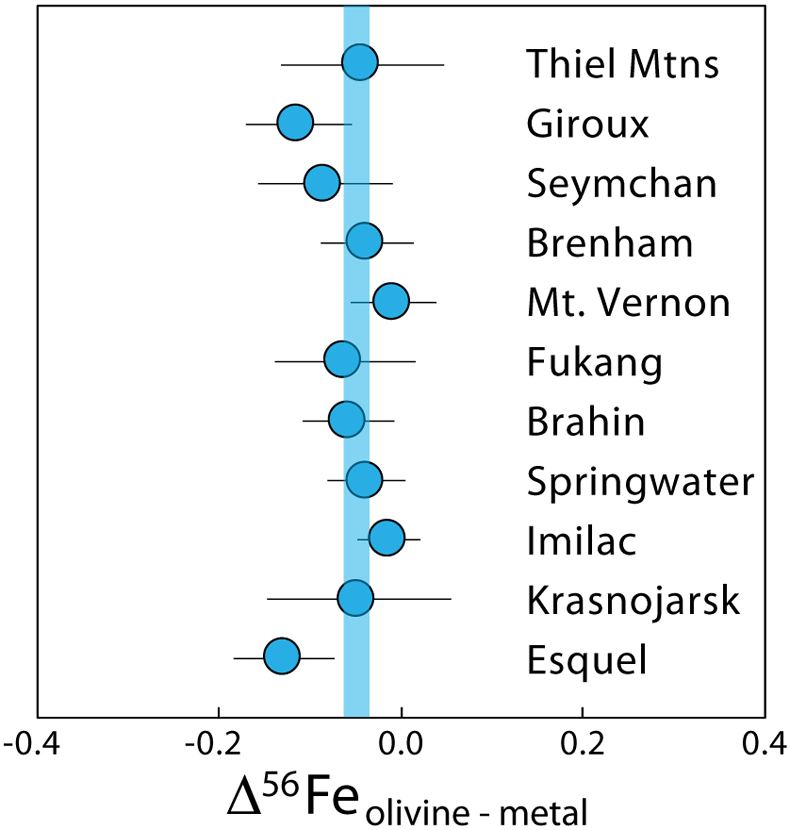
Figure 1 Measured Fe isotope fractionations between olivine and bulk metal in MGP. The blue band shows the weighted average for the 11 MGP measured in this study, plotted in order of cooling rate (Esquel slowest, Giroux fastest and Thiel Mtns. unknown; Yang et al., 2010
Yang, J., Goldstein, J.I., Scott, E.R. (2010) Main-group pallasites: thermal history, relationship to IIIAB irons, and origin. Geochimica et Cosmochimica Acta 74, 4471–4492. https://doi.org/10.1016/j.gca.2010.04.016
).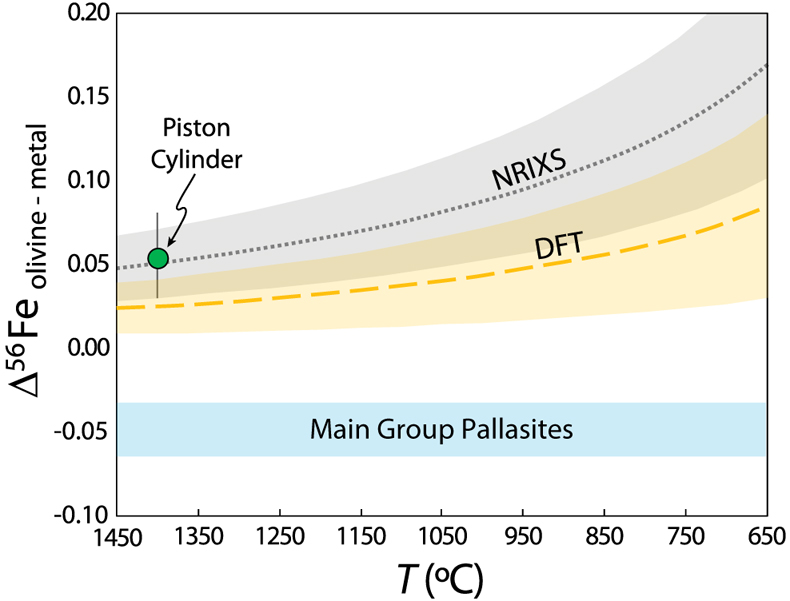
Figure 2 Grey and yellow bands show predicted olivine-metal Fe isotope fractionations at equilibrium, based on NRIXS and our DFT calculations, respectively. The piston cylinder datum is the weighted average of three isotopically equilibrated laboratory experiments. All methods show the same direction of equilibrium olivine-metal fractionation. MGP display the opposite sense of fractionation, suggesting that MGP olivine and metal are not in Fe isotopic equilibrium.
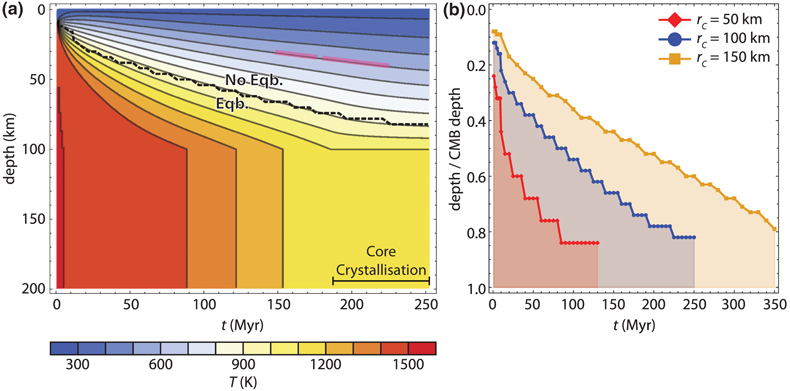
Figure 3 (a) Cooling and olivine-metal mass exchange model for a 200 km radius body with the core mantle boundary located at 100 km depth. The black dashed curve shows the time and depth of olivine-metal mixing above which Fe isotope equilibrium is inhibited. MGP formed above this curve. Also shown are the emplacement depths and periods of cloudy zone formation for the Imilac and Esquel meteorites, determined following Bryson et al. (2015)
Bryson, J.F., Nichols, C.I., Herrero-Albillos, J., Kronast, F., Kasama, T., Alimadadi, H., van der Laan, G., Nimmo, F., Harrison, R.J. (2015) Long-lived magnetism from solidification-driven convection on the pallasite parent body. Nature 517, 472–475. https://doi.org/10.1038/nature14114
. (b) Equilibrium curves for the same planetary radius but with different core radii (rC). The shaded regions indicate where olivine-metal equilibrium will occur for each model. Regardless of core size, olivine and metal always equilibrate when mixed near the core-mantle boundary. Note that in all cases models are terminated once the core is fully crystallised.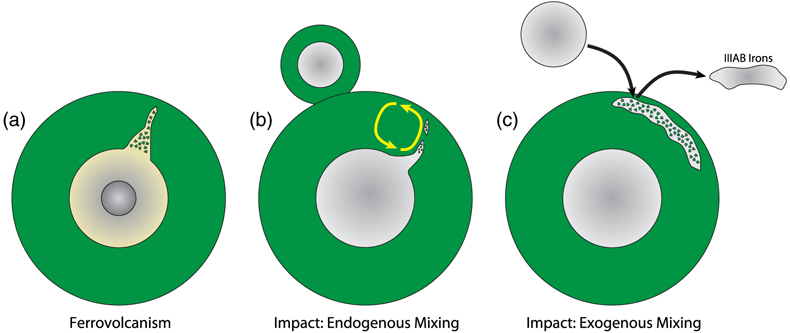
Figure 4 MGP formation models that account for shallow depths of olivine-metal mixing. Our Fe isotope data are most readily explained by model (c).






